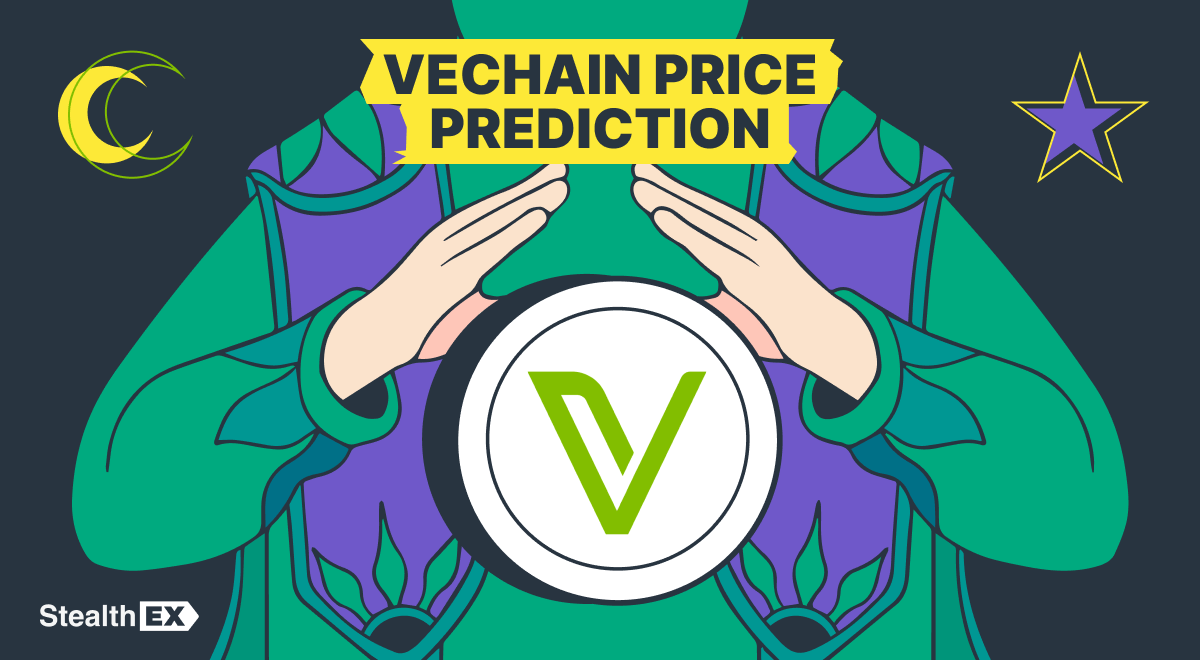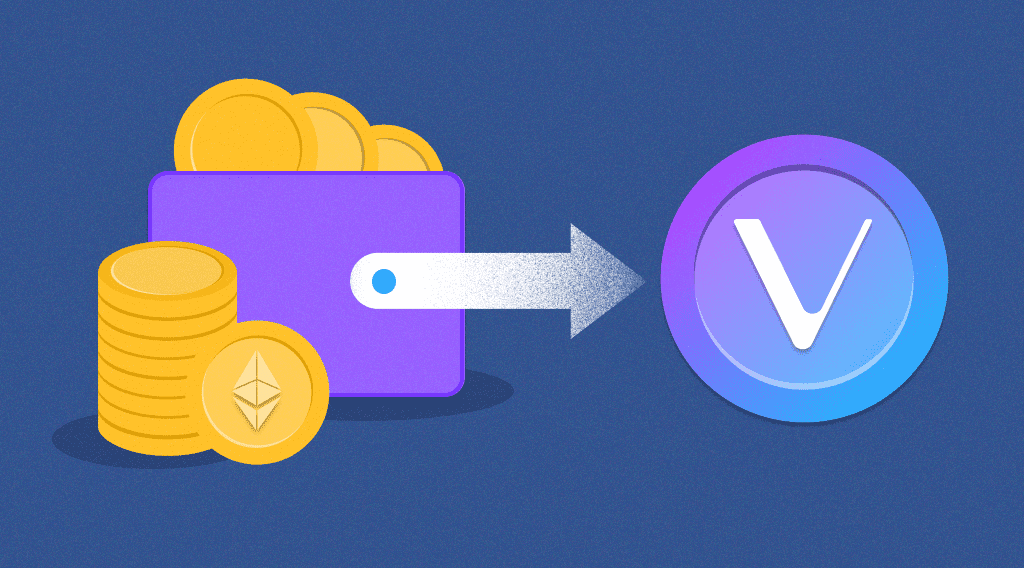Exchange VeChain (VET) at the Best Rates
Instantly exchange VeChain at the best price and with the lowest fees on StealthEX. Free from registration, fast, and limitless VET swaps. You can see for yourself how convenient it is.
VeChain (VET) Price Statistics
Price (USD)
$0.02127054Circulating Supply
$85.985BVolume (24h)
$26.8617MMarket Cap
$1.8296BLow/High 24h
$0.02034247 - $0.0212903Change (24h)
$0.00085812
VeChain: One of the Most Energy-Efficient Blockchains
Some cryptocurrencies have been on the market for a number of years and are seen as solid projects by the crypto community. One of these former crypto startups is VeChain. VeChain is a smart contract-compatible blockchain designed to enhance the supply chain and accelerate the mass adoption of blockchain technology. Let’s take a closer look at the VeChain properties and find out more about this project.
VeChain (VET) Overview
A public blockchain called VeChain or, later, VeChainThor is designed to enable widespread adoption of blockchain technology by businesses of all sizes by serving as the foundation for a robust and expandable enterprise blockchain ecosystem.
VeChain claims that despite being a substantial technological advance, Ethereum is still inadequate for the operation of massively scaled commercial dApps. It is due to Ethereum's weak governance system, which prevents rapid and transparent protocol updates to address new problems or innovations.
Additionally, the Ethereum blockchain lacks a suitable economic model, which prevents companies from running their dApps at a predictable and controllable cost. A company may also be unable to predict future Ethereum values or the cost of operating an Ethereum-based decentralized application for a set period of time considering how unstable the price of ETH is. Where does VeChain come in? Well, it intends to solve the above mentioned problems by utilizing meta-transaction features, a proof-of-authority (PoA) consensus technique, an on-chain governance mechanism, and a novel two-token structure.
VeChain features include the following:
- Multi-party payment: To support a decentralized application's freemium business model and facilitate user onboarding, various transaction fee delegation mechanisms are used. An organization can have a smart contract and dedicated gas account to manage the gas fees required to utilize the network thanks to VeChain's ground-breaking fee delegation protocol.
- Controllable transaction lifecycle: Using the Expiration and BlockRef transaction attributes, consumers can specify the time at which a transaction executes or expires if it is not contained in a block.
- Multi-task transaction: Using multi-function atomic transactions, developers can batch payments, incorporate numerous calls to different contract functions in a single transaction, and manage the order of the calls.
- Dependency on a transaction can be specified by users to prevent transactions from being executed until the pertinent transaction has been processed, ensuring that the execution order meets the needs of the company.
VeChain: History
VeChain was established in 2015 as a division of Bitse, a company that offers blockchain-powered solutions, by Sunny Lu, a former chief information officer of Louis Vuitton China, and Changpeng Zhao, a Chinese-Canadian founder of Binance. Originally using the Ethereum network, the VEN coin began to run on its own blockchain in 2018 under the name VeChainThor (VET).
VeChain wants to upend the supply chain business through data openness. The company has worked with a number of businesses to improve their business operations by utilizing the special characteristics of the VeChainThor blockchain, including Microsoft, PWC,BMW, Renault, and Volkswagen.
Governance in VeChain
Proof-of-Authority is the consensus protocol used by the VeChainThor blockchain. Votes are distributed in accordance with this protocol based on VET holdings and disclosure. 20% of the total votes go to VET holders without know-your-customer (KYC) credentials and 1 million tokens in their wallets, while 30% go to holders of KYC and the same number of tokens.
The VeChain blockchain's 101 master nodes are in charge of achieving consensus on transactions. This approach differs from Bitcoin in that it enables consensus without requiring a vote from all nodes.
Disclosure of identification is a necessary prerequisite for becoming an authority master node, thus anonymous nodes are not permitted. The white paper from VeChain claims that this method utilises less power and does not need a specific quantity of validators to attain consensus.
The economic master node is the other sort of master node in VeChain. These serve as a power check because they don't generate blocks or ledger records. This is accomplished by giving each economic master node a specific number of votes based on their VET holdings. A single vote is granted to an economic master node for every 10,000 VET it holds.
Voting rights in a decentralized system are centralized by the master node system. However, the VeChain founders have stated that they wanted to strike a compromise between centralization and decentralization when creating this protocol.
What Is VET Crypto?
VeChain Token (VET) and VeChainThor Energy (VTHO) are the two tokens that make up the VeChain ecosystem. The first token, VET, is used to send money to other VeChain users as well as to create the second token, VTHO. Transaction fees, platform gas charges, and smart contract development expenses are all paid for with the VTHO token.
Since the VTHOR supply may be changed to maintain a steady pricing for transactions, this design aims to separate the price volatility of the VET coin from the cost of computations on the network, enabling applications on VeChain to charge predictable fees. The VTHO blockchain employs ETH and gas in a similar way to the Ethereum blockchain, and miners are paid VTHO fees for network calculations. The more VTHO a given programme needs, the more complex the computation. Last but not least, nodes staking VET money get to vote on network updates and get VTHO every time a block is mined.
Along with its supply chain applications, VeChain also has a vibrant NFT ecosystem. VeSea is a decentralized NFT exchange that allows for the creation and trading of VIP-181 tokens that are stored on the VeChain network. The VIP-181 Standard, which was introduced by the VeChain Foundation, makes it possible for tokens used in smart contracts to perform basic functions.
To sell, buy, and store NFTs on VeSea, which is compatible with VeChain Sync2 and VeChain Wallet, users need a VeChain-compatible wallet. VeSea also incurs no gas costs because of the efficiency of the underlying blockchain. However, there is a 2.5% trading fee that users must pay.
VeChain Price Prediction
It’s exceptionally difficult to predict the future of any digital asset within even a year, however, it’s a daunting task to give predictions that span over several decades. Resources like Telegaon believe that by 2040, VET crypto will cost $4.23-$5.25 per coin, which may be possible with wider cryptocurrency adoption and industry growth. Additionally, VeChain continues to develop as a blockchain, entering into more partnerships, like the recent one with Reflexivity or BGG.
The current price of VeChain (VET) is $0.02127054.
Is Vechain a Good Investment?
VeChain seeks to solve problems like the high cost of operating an Ethereum-based dApp in order to hasten the widespread adoption of blockchain technology. One of the factors an investor must look into is the security and the reliability of the digital asset. How secure is the VeChain network? VeChain collaborates with several security firms, such as Hosho, Secureware, SlowMist, and HackenProof, to identify potential weaknesses and proactively thwart online threats.
Nevertheless, despite the application cases for VeChain in supply chain management and other sectors, the decision to invest depends on one's financial goals and risk-return profile. It might be risky to buy in a cryptocurrency in which you lack sufficient confidence as it can lead to financial losses. As any cryptocurrency, VET crypto is highly volatile, even though it enters Top-50 largest cryptocurrencies by market cap.
How to Buy VeChain?
StealthEX is here to help you buy VET coin. You can do this privately and without the need to sign up for the service. Our crypto collection has more than 1500 different coins and you can do wallet-to-wallet transfers instantly and problem-free.
Just go to StealthEX and follow these easy steps:
- Choose the pair and the amount you want to exchange — for instance, BTC to VET.
- Press the “Start exchange” button.
- Provide the recipient address to transfer your crypto to.
- Process the transaction.
- Receive your crypto coins.
Follow us on Medium, X, Telegram, YouTube, and Publish0x to stay updated about the latest news on StealthEX.io and the rest of the crypto world.
Don’t forget to do your own research before buying any crypto. The views and opinions expressed in this article are solely those of the author.
VeChain Price Chart
VeChain (VET)
Related Articles

Price Prediction
VeChain Price Prediction: Is VET Crypto a Good Investment?
According to the long-term VeChain price prediction, by the end of 2030, the VET crypto price is expected to reach a maximum...

How to Buy
How to Buy VeChain Coin?
Looking for information on how to buy VeChain coin? Then you have come to the right place. This article will also tell you w...

Price Prediction
Check Out VeChain Price Prediction: VET Price Forecast
If you are looking for information on VeChain price prediction, then you have come to the right place. In this article, we w...
StealthEX.io uses cookies to ensure you get the best experience. Please read our cookies policy